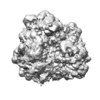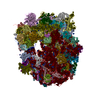+ Open data
Open data
- Basic information
Basic information
| Entry | Database: EMDB / ID: EMD-3745 | |||||||||
|---|---|---|---|---|---|---|---|---|---|---|
| Title | Cryo-EM structure of the foot-containing 80S ribosome | |||||||||
 Map data Map data | Programmed foot-containing 80S ribosome | |||||||||
 Sample Sample |
| |||||||||
| Biological species |  | |||||||||
| Method | single particle reconstruction / cryo EM / Resolution: 7.3 Å | |||||||||
 Authors Authors | Sarkar A / Thoms M / Barrio-Garcia C / Thomson E / Flemming D / Beckmann R / Hurt E | |||||||||
 Citation Citation |  Journal: Nat Struct Mol Biol / Year: 2017 Journal: Nat Struct Mol Biol / Year: 2017Title: Preribosomes escaping from the nucleus are caught during translation by cytoplasmic quality control. Authors: Anshuk Sarkar / Matthias Thoms / Clara Barrio-Garcia / Emma Thomson / Dirk Flemming / Roland Beckmann / Ed Hurt /  Abstract: Assembly of fully functional ribosomes is a prerequisite for failsafe translation. This explains why maturing preribosomal subunits have to pass through an array of quality-control checkpoints, ...Assembly of fully functional ribosomes is a prerequisite for failsafe translation. This explains why maturing preribosomal subunits have to pass through an array of quality-control checkpoints, including nuclear export, to ensure that only properly assembled ribosomes engage in translation. Despite these safeguards, we found that nuclear pre-60S particles unable to remove a transient structure composed of ITS2 pre-rRNA and associated assembly factors, termed the 'foot', escape to the cytoplasm, where they can join with mature 40S subunits to catalyze protein synthesis. However, cells harboring these abnormal ribosomes show translation defects indicated by the formation of 80S ribosomes poised with pre-60S subunits carrying tRNAs in trapped hybrid states. To overcome this translational stress, the cytoplasmic surveillance machineries RQC and Ski-exosome target these malfunctioning ribosomes. Thus, pre-60S subunits that escape nuclear quality control can enter translation, but are caught by cytoplasmic surveillance mechanisms. | |||||||||
| History |
|
- Structure visualization
Structure visualization
| Movie |
 Movie viewer Movie viewer |
|---|---|
| Structure viewer | EM map:  SurfView SurfView Molmil Molmil Jmol/JSmol Jmol/JSmol |
| Supplemental images |
- Downloads & links
Downloads & links
-EMDB archive
| Map data |  emd_3745.map.gz emd_3745.map.gz | 123.9 MB |  EMDB map data format EMDB map data format | |
|---|---|---|---|---|
| Header (meta data) |  emd-3745-v30.xml emd-3745-v30.xml emd-3745.xml emd-3745.xml | 8.2 KB 8.2 KB | Display Display |  EMDB header EMDB header |
| Images |  emd_3745.png emd_3745.png | 62.9 KB | ||
| Archive directory |  http://ftp.pdbj.org/pub/emdb/structures/EMD-3745 http://ftp.pdbj.org/pub/emdb/structures/EMD-3745 ftp://ftp.pdbj.org/pub/emdb/structures/EMD-3745 ftp://ftp.pdbj.org/pub/emdb/structures/EMD-3745 | HTTPS FTP |
-Validation report
| Summary document |  emd_3745_validation.pdf.gz emd_3745_validation.pdf.gz | 241.6 KB | Display |  EMDB validaton report EMDB validaton report |
|---|---|---|---|---|
| Full document |  emd_3745_full_validation.pdf.gz emd_3745_full_validation.pdf.gz | 240.7 KB | Display | |
| Data in XML |  emd_3745_validation.xml.gz emd_3745_validation.xml.gz | 7.3 KB | Display | |
| Arichive directory |  https://ftp.pdbj.org/pub/emdb/validation_reports/EMD-3745 https://ftp.pdbj.org/pub/emdb/validation_reports/EMD-3745 ftp://ftp.pdbj.org/pub/emdb/validation_reports/EMD-3745 ftp://ftp.pdbj.org/pub/emdb/validation_reports/EMD-3745 | HTTPS FTP |
-Related structure data
| Similar structure data |
|---|
- Links
Links
| EMDB pages |  EMDB (EBI/PDBe) / EMDB (EBI/PDBe) /  EMDataResource EMDataResource |
|---|---|
| Related items in Molecule of the Month |
- Map
Map
| File |  Download / File: emd_3745.map.gz / Format: CCP4 / Size: 216 MB / Type: IMAGE STORED AS FLOATING POINT NUMBER (4 BYTES) Download / File: emd_3745.map.gz / Format: CCP4 / Size: 216 MB / Type: IMAGE STORED AS FLOATING POINT NUMBER (4 BYTES) | ||||||||||||||||||||||||||||||||||||||||||||||||||||||||||||
|---|---|---|---|---|---|---|---|---|---|---|---|---|---|---|---|---|---|---|---|---|---|---|---|---|---|---|---|---|---|---|---|---|---|---|---|---|---|---|---|---|---|---|---|---|---|---|---|---|---|---|---|---|---|---|---|---|---|---|---|---|---|
| Annotation | Programmed foot-containing 80S ribosome | ||||||||||||||||||||||||||||||||||||||||||||||||||||||||||||
| Projections & slices | Image control
Images are generated by Spider. | ||||||||||||||||||||||||||||||||||||||||||||||||||||||||||||
| Voxel size | X=Y=Z: 1.084 Å | ||||||||||||||||||||||||||||||||||||||||||||||||||||||||||||
| Density |
| ||||||||||||||||||||||||||||||||||||||||||||||||||||||||||||
| Symmetry | Space group: 1 | ||||||||||||||||||||||||||||||||||||||||||||||||||||||||||||
| Details | EMDB XML:
CCP4 map header:
| ||||||||||||||||||||||||||||||||||||||||||||||||||||||||||||
-Supplemental data
- Sample components
Sample components
-Entire : Foot-containing 80S ribosome TAP-Flag-Nop53 Las1-HA-Aid
| Entire | Name: Foot-containing 80S ribosome TAP-Flag-Nop53 Las1-HA-Aid |
|---|---|
| Components |
|
-Supramolecule #1: Foot-containing 80S ribosome TAP-Flag-Nop53 Las1-HA-Aid
| Supramolecule | Name: Foot-containing 80S ribosome TAP-Flag-Nop53 Las1-HA-Aid type: complex / ID: 1 / Parent: 0 |
|---|---|
| Source (natural) | Organism:  |
-Experimental details
-Structure determination
| Method | cryo EM |
|---|---|
 Processing Processing | single particle reconstruction |
| Aggregation state | particle |
- Sample preparation
Sample preparation
| Buffer | pH: 7.5 |
|---|---|
| Grid | Model: Quantifoil / Support film - Material: CARBON / Support film - topology: HOLEY / Support film - Film thickness: 2.0 nm |
| Vitrification | Cryogen name: ETHANE / Instrument: FEI VITROBOT MARK IV |
- Electron microscopy
Electron microscopy
| Microscope | FEI TITAN KRIOS |
|---|---|
| Image recording | Film or detector model: FEI FALCON II (4k x 4k) / Average electron dose: 30.0 e/Å2 |
| Electron beam | Acceleration voltage: 300 kV / Electron source:  FIELD EMISSION GUN FIELD EMISSION GUN |
| Electron optics | Illumination mode: SPOT SCAN / Imaging mode: BRIGHT FIELD |
| Experimental equipment |  Model: Titan Krios / Image courtesy: FEI Company |
- Image processing
Image processing
| Final reconstruction | Resolution.type: BY AUTHOR / Resolution: 7.3 Å / Resolution method: FSC 0.143 CUT-OFF / Software - Name: FREALIGN / Number images used: 4869 |
|---|---|
| Initial angle assignment | Type: PROJECTION MATCHING / Software - Name: FREALIGN |
| Final angle assignment | Type: PROJECTION MATCHING / Software - Name: FREALIGN |
| Final 3D classification | Software - Name: FREALIGN |
 Movie
Movie Controller
Controller















 Z (Sec.)
Z (Sec.) Y (Row.)
Y (Row.) X (Col.)
X (Col.)





















